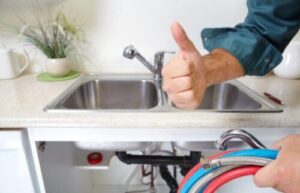10 Beneficial Plumbing Tips for Beginners
If you’ve just purchased a home, whether to live in or rent, then maintenance is something you’ll have to learn about. Plumbing, in particular, is going to be a necessity. While you can (and should) hire a professional for larger jobs, those that are smaller may be things that you can do on your own. To help you along the way, take a look at the ten best tips for beginners below.
- Don’t Replace Your Shower head
A clogged shower head can be irritating to deal with while you’re showering. Fortunately, you don’t have to replace the shower head to fix this problem. Instead, remedy this by filling a plastic sandwich bag with a mixture of water and vinegar. Tie this over the shower head with a rubber band and allow to soak for around an hour. Once finished, use a cheap toothbrush to clean off any blockages in the holes and you’ll be good to go.
- Check Your Thermostat
Your water heater only needs to be set at around 115 degrees in order to provide you with an adequate amount of heat. It’s not necessary to have it set higher than this, so make sure to monitor it throughout the year. You can also insulate the tank (as long as you don’t cover the thermostat) to help water stay hot for longer.
- Tackle Toilet Part Replacements
It can be intimidating to look inside of your toilet tank and see all of the parts that make it up. This is a huge reason why many homeowners avoid improvements that are actually simple to do. In fact, one of the easiest improvements you can do is replace the flappers. These are affordable, come with instructions, and can be done by beginners quite easily. As long as you turn off the water and read thoroughly before you get started, you should be able to tackle toilet tank replacements with confidence.
- Fix Clogs Without Dangerous Chemicals
When dealing with a clogged toilet, it can be tempting to pour a chemical down the drain to break down whatever is stuck inside. However, these chemicals can damage your pipes and even your toilets, so it’s best to try other options first. This includes using pipe snakes and plungers according to package directions. Many homeowners even find success with pouring warm soapy water into the toilet to help break down the clog.
- Don’t Ignore Leaks
Leaking water can be stressful for homeowners, especially if you’re the one who has to deal with fixing it. While you can place a towel over the area to temporarily soak up the water, it’s important to address the issue right away. If you let it sit for days or weeks, the problem is only going to get worse. In fact, allowing a leak to sit can even lead to water damage that eventually causes mold to grow. If you don’t know what is causing the leak, the plumbers at Conrad Martens Plumbing and Gas recommend calling a professional immediately.
- Have Thread Tape In Your Home
Thread tape is something you’ll want to keep on hand for various plumbing projects. This simply needs to be wrapped around the threads of a pipe to create a tight and reliable seal. However, you must wrap it in a clockwise direction in order for it to be effective.
- Invest in a Toolbox
In order to actually do plumbing work inside of your home, you’ll have to invest in some high-quality tools. Fortunately, you only need to buy these once and then you’ll be able to do a wide variety of projects as they are needed. This set should include a plumbing snake, adjustable pipe wrench, toilet auger, and flange plunger to start. If you find that you’re pretty good at doing these types of projects, then it’s very likely you’ll end up with many more tools than this over the years.
- Always Turn Off the Water
The #1 rule in plumbing is to turn the water off before you do any sort of project. If you’re not sure where the main water line is, take a look around the outside of your home. Chances are, it’s going to be located in an easy-to-find spot that you simply didn’t notice in the past. Practice turning it on and off a few times to ensure you know how it works before you need to use it.
Tip: Also familiarize yourself with the location of water supply valves under sinks and appliances so you can turn off the water in specific areas as well.
- Learn How to Replace Seals
One of the most common reasons why leaks occur in faucets is because the seals are worn out. If you’re willing to spend a little bit of time working on the problem, it’s very likely you can repair this yourself. All you have to do is turn the water supply off and remove the handle to the faucet. From there, take everything apart (remember the order they go in) until you find the seal. Then, replace the seal with a new one and put everything back together. This is one of the easiest plumbing projects you can do that can save you time and money.
- Keep the Kitchen Sink Clean
Avoid dumping grease or oils down your kitchen sink drain, as these are likely to solidify and cause major drainage issues down the road. You should also avoid putting large pieces of food into the drain, even if you have a garbage disposal. In general, you’ll want to throw as much food and grease/oil in the trash as you can before placing dishes into the sink.
Tackling Plumbing Problems at Home
Even a new home can experience plumbing problems over time. It’s for this reason that homeowners should always be vigilant and look out for issues such as leaks or strange noises. If you want to do more in your home to save yourself some money, try doing DIY basic DIY repairs first. However, if you run into a problem you just can’t do, always call a plumber for their expertise and assistance.






